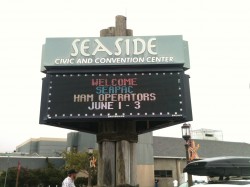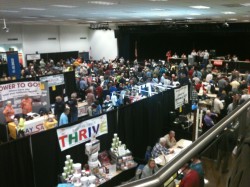I just returned from an awesome weekend in Seaside, Oregon where I attended the SEA-PAC convention, an annual gathering of amateur radio operators at the Seaside Convention Center.
First, a little back story: I’ve been a HAM for 9 years, call KG6PFU, but I’ve not yet been on the air. While attending Cal Poly I became involved with the Cal Poly Picosatellite Program, also known as PolySat. The aim of this program was to involve engineering students in an extracurricular project to design, build, and deploy an orbital satellite capable of remote sensing and downlinking telemetry on a HAM band. Because picosatellite communication involved using HAM radio frequencies, a number of the engineering students involved in the project took the FCC licensing examination and obtained our technician class licenses. Due to external commitments and schoolwork, I was only involved with PolySat for a short time and never had a chance to use my new privileges. Fast forward 9 years and I’m still a licensed HAM with a license that is about to expire, and I’ve still never been on the air.
Just a few months ago, I attended an emergency preparedness fair at our local LDS Ward where a HAM gave a talk about amateur radio and its applications in emergency communications. This piqued my interest and set me on the path to renew my license, buy a radio and start exploring this amazing hobby. To this to end, I’ve been listening to amateur radio podcasts, studying for the general class test and attending related events, such as a class put on by a local HAM and SEA-PAC.
In fact, I learned about SEA-PAC in my HAM class just a few weeks before the event. Because it was held in Seaside, where my wife’s family has a beach house, I knew I wouldn’t have to find (or pay for) lodging, so attending was an easy choice. Not surprisingly, there was zero parking in any of the lots around the convention center, so I was grateful to my wife and daughter for dropping me off. The event was broken down into three sections: radio manufacturer booths, a swap meet, and a series of hour-long seminars about various topics in amateur radio.
Seminars
As a HAM without any practical experience in the hobby, I spent the majority of my time in the seminars, the first one introducing the near vertical incidence skywave antenna (NVIS) and its applications. The NVIS antenna is designed to propagate RF directly up to the ionosphere where it is refracted back down to the surface, covering an area up to 650 km from the transmitter. This is especially useful for mountainous areas (like thePacific Northwest) where line of sight communication is problematic due to geographic barriers. This talk was primarily geared toward setting up an EOC (emergency operations center) on an HF frequency which was beyond the scope of my current interest in amateur radio. I still found the talk interesting and loved the coverage of antenna design, an aspect of my electrical engineering background that is severely lacking.
The second seminar covered the National Traffic System (NTS) and the protocol for sending messages over NTS. It has been said that when the internet goes down, the power grid fails and the world goes dark, HAM radio will still work. Because of this, the NTS system exists to route traffic from one operator to another, to and from any point in theUnited States. This is accomplished using a very specific protocol for sending and receiving messages and recording message content onto radiograms. Much like a digital wireless protocol, there is physical layer and a transport layer with “encoded” data and error checking and correction. Messages are not necessarily relayed via voice, as Morse code is fair game as well. Once I purchase a radio I’ll probably focus on how to integrate myself with NTS, unless communicating through satellites takes priority.
The final seminar was, by far, my favorite. It covered communicating with orbital satellites carrying amateur radio (OSCARs) using only a 5W handheld radio and a directional Yagi antenna. I always thought I’d need an expensive ground station with motorized tracking antennas to talk to satellites, but this presenter showed his audience that it’s not only possible, but relatively easy with inexpensive home-made antennas. This is was what motivated me to obtain my HAM license 9 years ago, so this talk really inspired me. The presenter, Daron Wilson (N7HQR), also showed video of his communications with Doug Wheelock, commander of the International Space Station (ISS) using a home-made Yagi!
The OSCARs typically carry a transmitter and receiver which use different bands. In effect, they are a repeater in the sky. Unlike a terrestrial repeater, they cover a much wider area and allow HAMs with a simple 5W handheld to reach the other side of theUnited States. The talk covered the appropriate radios and antennas necessary to reach a satellite. It also covered tracking satellite azimuth and elevation with orbit predicting software. At this point I have a solid understand of what I need to start making contacts via satellite and this is very exciting!
Amateur Radio Companies & Swap Meet
I only spent an hour touring the booths from HAM radio related companies. Icom and Yaesu both had a presence at the show and both had handhelds that looked appealing. I grabbed a bunch of literature from their booths and currently I’m looking seriously at the Icom IC-92.
The upper level of the convention center was basically a swap meet with an array of vendors selling what looked like junk to me. I’m sure that were plenty of treasures to be found here, but I didn’t have the confidence to buy anything without knowing what I was buying or if I was getting a good price. I’m hoping to explore this area of the convention in much more depth next year.
What I Missed Out On
I ran into a HAM at church Sunday morning and discovered that the speaker at Saturday night’s dinner was a NASA astronaut, Dr. Michael Barratt, who is a HAM himself. He fielded an array of complex questions from the audience and spoke about communicating over amateur radio from an orbital platform. This was an epic fail for me since I neglected to read the brochure which clearly listed the guest speakers.
Final Thoughts
One thing that really struck me from the moment I walked in the door was the fact that I was clearly the youngest person there – and not by a couple years. The majority of the attendees were men in their 60s and up, nearly all sporting a backpack with a two meter dipole antenna sticking out of a half-zipped pocket. At one point during a seminar I noticed that the man sitting to my right had fallen asleep when he started snoring! Then it happened again (different person) in the following seminar! Yes, I definitely stuck out like a sore thumb at this event. Now perhaps the demographic is shaped by the fact that most HAMs got started in the hobby before the advent of the Internet. Perhaps it is due to the fact that many aspects of amateur radio, like owning and flying a home-built airplane, are expensive and only affordable by retirees who have spent a lifetime of saving money. Perhaps the age demographic is due to other factors, but regardless of the reason, it doesn’t bode well for the hobby – especially if new HAMs are not being licensed in high enough numbers to replace those HAMs who have become silent keys (deceased HAM).
With that being said, I did have a great time at the event and I learned a lot. I now have some direction and understanding of what I need to do to make it happen. I’ll be taking the general class test in a few weeks and upgrading my tech class license. I plan to purchase a radio in the coming months and hopefully make my first contact – perhaps through a satellite. I think I’ll enjoy this hobby immensely as it blends my interest in RF, long-distance communications, and emergency prepping with my background in electrical engineering. That’s some impressive synergy.


